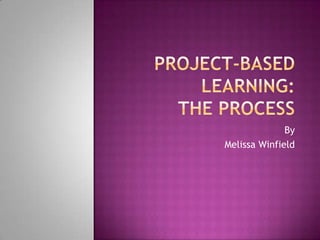Report
Share

Recommended
Recommended
Finnish Teachers as Users and Creators of Learning Environments that Promote ...

Finnish Teachers as Users and Creators of Learning Environments that Promote ...Minna Riikka Järvinen
More Related Content
What's hot
Finnish Teachers as Users and Creators of Learning Environments that Promote ...

Finnish Teachers as Users and Creators of Learning Environments that Promote ...Minna Riikka Järvinen
What's hot (20)
using Project as a procedure for famative assesssment

using Project as a procedure for famative assesssment
Finnish Teachers as Users and Creators of Learning Environments that Promote ...

Finnish Teachers as Users and Creators of Learning Environments that Promote ...
Similar to Project based learning the process
PBL stands for project-based learning, which is a student-centered pedagogy that incorporates an active classroom approach. The idea behind this method of teaching is that students would gain a more in-depth knowledge via the active investigation of real-world issues and obstacles. Features of Project-based learning; 1. Student-centered 2. Interdisciplinary ...

Features of Project-based learning; 1. Student-centered 2. Interdisciplinary ...Future Education Magazine
5 Steps to Get Started With Project-based Learning: 1. What is the goal? 2. Choose a specific problem or question 3. Plan and facilitate the process 4. Demo time! 5. ReflectionProject-Based Learning in Classroom: 5 Best Steps To Start | Future Education...

Project-Based Learning in Classroom: 5 Best Steps To Start | Future Education...Future Education Magazine
Similar to Project based learning the process (20)
Features of Project-based learning; 1. Student-centered 2. Interdisciplinary ...

Features of Project-based learning; 1. Student-centered 2. Interdisciplinary ...
Project-Based Learning in Classroom: 5 Best Steps To Start | Future Education...

Project-Based Learning in Classroom: 5 Best Steps To Start | Future Education...
More from mwinfield1
More from mwinfield1 (20)
Technology in the classroom teaching in new creative ways

Technology in the classroom teaching in new creative ways
An overview of visual, auditory, and kinesthetic learners

An overview of visual, auditory, and kinesthetic learners
Project based learning the process
- 2. John Thomas (2000) explains that project- based learning requires “complex tasks, based on challenging questions or problems, that involve students in design, problem- solving, decision making, or investigative activities; give students the opportunity to work relatively autonomously over extended periods of time; and culminate in realistic products or presentations.”
- 3. Begin with the end in mind and plan for this end result. Craft the driving question; select and refine a central question. Plan the assessment and define outcomes and assessment criteria. Map the project: Decide how to structure the project. Manage the process: Find tools and strategies for successful projects.
- 4. Asking and refining questions Debating ideas Making predictions Designing plans and/or experiments Collecting and analyzing data Drawing conclusions Communicating ideas and findings to others Asking new questions Creating artifacts
- 5. In project-based learning teachers support students by giving sufficient guidance and feedback. The teacher must thoroughly explain all tasks that are to be completed, provide detailed directions for how to develop the project, and circulate within the classroom in order to answer questions and encourage student motivation.
- 6. Students generally work in small, collaborative groups in the project-based learning model. They find sources, conduct research, and hold each other responsible for learning and the completion of tasks. Essentially, students must be “self-managers” in this approach to instruction
- 7. Teachers can assess project-based learning with a combination of objective tests, checklists, and rubrics; however, these often only measure task completion. The inclusion of a reflective writing component provides for self-evaluation of student learning.
- 8. Objective: Students will discover the significance of inventions created by African Americans inventors in their daily lives. Studentswill research African American inventors and create various models, diagrams and charts using internet resources.